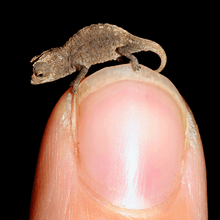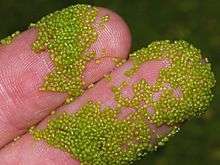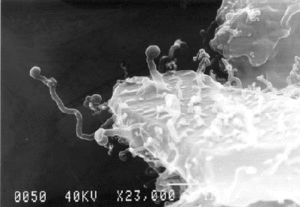Smallest organisms
The smallest organisms found on Earth can be determined according to various aspects of organism size; including volume, mass, height, length, or genome size.
Given the incomplete nature of scientific knowledge, it is possible that the smallest organism is undiscovered. Furthermore, there is some debate over the definition of life, and what entities qualify as organisms; consequently the smallest known organism (microorganism) is debatable.
Microorganisms
Viruses
Many biologists consider viruses to be non-living because they lack a cellular structure and cannot metabolize by themselves, requiring a host cell to replicate and synthesise new products. A minority of scientists hold that, because viruses do have genetic material and can employ the metabolism of their host, they can be considered organisms. The smallest RNA viruses in terms of genome size are small retroviruses such as rous sarcoma virus with genomes of 3.5 kilo base pairs (kb) and particle diameters of 80 nanometres (nm). The smallest double stranded DNA viruses are the hepadnaviruses such as Hepatitis B, at 3.2 kb and 42 nm; parvoviruses have smaller capsids, at 18-26 nm, but larger genomes, at 5 kb. The smallest DNA bacteriophage is the Phi-X174 phage, thought to be larger than Hepatitis B, at about 4 kb.[1] It is important to consider other self replicating genetic elements, such as satelliviruses, viroids and ribozymes.
The smallest virus known to humanity, however, is the single-stranded DNA virus Porcine circovirus type 1. It has a genome of only 1759 nucleotides[2] and a capsid diameter of only 17 nm.[3] As a whole, the viral family geminiviridae is only about 30 nm in length. However, the two capsids making up the virus are fused; divided, the capsids would be 15 nm in length.
Shortest non-viral germs
Candidatus Carsonella ruddii; genome consists of a circular chromosome of 159,662 base pairs. Nanoarchaeum equitans; genome is 490,885 nucleotides long.
Pelagibacter ubique
Pelagibacter ubique is one of the smallest known free-living bacterium with a length of 0.37-0.89 μm and an average cell diameter of 0.12-0.20 μm. They also have the smallest free-living bacterium genome; 1.8Mbp, 1354 protein genes, 35 RNA genes. They are one of the most common and smallest organisms in the ocean, with their total weight equaling more than all fish presently in the sea.[4]
Mycoplasma genitalium
Mycoplasma genitalium, a parasitic bacterium which lives in the primate bladder, waste disposal organs, genital, and respiratory tracts, is thought to be the smallest known organism capable of independent growth and reproduction. With a size of approximately 200 to 300 nm, M. genitalium is an ultramicrobacterium, smaller than other small bacteria, including rickettsia and chlamydia. However, the vast majority of bacterial strains have not been studied, and the marine ultramicrobacteria Sphingomonas sp strain RB2256 is reported to have passed through a 220 nm ultrafilter. A complicating factor is nutrient-downsized bacteria, bacteria that become much smaller due to a lack of available nutrients.[5]

Nanoarchaeum
Nanoarchaeum equitans is a species of tiny microbe 400 nm in diameter. It was discovered in 2002 in a hydrothermal vent off the coast of Iceland by Karl Stetter. A thermophile that grows in near-boiling temperatures, Nanoarchaeum appears to be an obligatory symbiont on the archaeon Ignicoccus; it must be in contact with the host organism to survive.
Eukaryotes
Prasinophyte algae of the genus Ostreococcus is the smallest free-living eukaryote. The single cell of an Ostreococcus measures only 0.8 μm across. The smallest genome of any Eukaryote is Guillardia theta, with a genome size of only 551 Kilobases.
Animals
Several species of Myxozoa never grow larger than 20 µm.[6] One of the smallest species (Myxobolus shekel) is no more than 8.5 µm when fully grown.[7]
Molluscs
The smallest water snail (of all snails) is Ammonicera minortalis in North America, originally described from Cuba. It measures 0.32 to 0.46 mm.[8][9]
The smallest land snail is Acmella nana. Discovered in Borneo, Malaysia, and described in November 2015, it measures only 0.7 mm.[10] The previous record was that of Angustopila dominikae from China, which was reported in September 2015. This snail measures 0.86 mm.[11]
Arthropods
Smallest crustacean
The smallest crustacean, and indeed the smallest arthropod, is the tantulocarid Stygotantulus stocki, at a length of only 94 µm (0.0037 in).[12]
Arachnids
Eriophyid mites measure 125 to 250 μm in length.[13]
Insects
Adult males of the parasitic wasp Dicopomorpha echmepterygis can be as small as 139 μm long, smaller than some species of protozoa (single-cell creatures); females are 40 percent larger.[14]
Megaphragma caribea from Guadeloupe, measuring 170 μm long, is another contender for smallest known insect in the world.
- Beetles
Beetles of the tribe Nanosellini are all less than 1 mm long; the smallest confirmed specimen is of Scydosella musawasensis at 325 μm long; a few other nanosellines are reportedly smaller, in historical literature, but none of these records have been confirmed using accurate modern tools. These are among the tiniest non-parasitic insects.[15]
Echinoderms
The smallest sea cucumber, and also the smallest echinoderm, is Psammothuria ganapati, a synaptid that lives between sand grains on the coast of India. Its maximum length is only 4 mm.[16] [17]
Sea urchins
The smallest sea urchin, Echinocyamus scaber, has a test only 6 mm across.[17]
Starfish
Patiriella parvivipara is the smallest starfish, at only 5 mm across.[17]
Vertebrates
.png)
The smallest vertebrates (and smallest amphibians) known are Paedophryne amauensis frogs from Papua New Guinea, which range in length from 7.0–8.0 millimetres (0.28–0.31 in), and average 7.7 millimetres (0.30 in).[18][19] Previously, the title of smallest vertebrate was held by members of the fish genus Paedocypris of Indonesia.
Fish
The world's smallest fish is Paedocypris progenetica from Indonesia, with mature females measuring 7.9 mm (0.31 in). This fish, a member of the carp family, has a translucent body and a head unprotected by a skeleton.
Ray-finned
Male individuals of the anglerfish species Photocorynus spiniceps have been documented to be 6.2–7.3 millimetres (0.24–0.29 in) at maturity, and thus claimed to be a smaller species. However, these survive only by sexual parasitism and the female individuals reach the significantly larger size of 50.5 millimetres (1.99 in).[20][21][22][23]
List of smallest fishes in the world
| Image | Common Name | Species | Family | Length mm (in) |
|---|---|---|---|---|
| Paedocypris | Paedocypris progenetica | Cyprinidae | 7.9 mm (0.31 in) | |
| Dwarf pygmy goby | Pandaka pygmaea | Gobiidae | 9 mm (0.35 in) | |
| Stout infantfish[24] | Schindleria brevipinguis | Schindleriidae | 8.4 mm (0.33 in) | |
| Dwarf goby[25] | Trimmatom nanus | Gobiidae | 10 mm (0.39 in) |
Amphibians
Salamanders
The average length of several specimens of the salamander Thorius arboreus was only 17 millimetres (0.67 in).
Reptiles
Lizards

The dwarf gecko (Sphaerodactylus ariasae) and the Virgin Islands dwarf sphaero (S. parthenopion), two geckos in the genus Sphaerodactylus, are the world's smallest known reptile species and smallest lizard, with a snout-vent length of 16 millimetres (0.63 in).[26] A few Brookesia chameleons from Madagascar are equally small, with a reported snout-vent length of 15–18 millimetres for male dwarf chameleons (B. minima), 14–19 millimetres for male Mount d'Ambre leaf chameleons (B. tuberculata)[27] and 15–16 millimetres for male B. micra,[28] though females are larger. Of the aforementioned geckos, S. ariasae was first described in 2001 by the biologists Blair Hedges and Richard Thomas. This dwarf gecko is endangered and lives in Jaragua National Park in the Dominican Republic and on Beata Island (Isla Beata), off the southern coast of Hispaniola in the Dominican Republic.[29][30]
Turtles
The world's smallest turtle is the speckled padloper tortoise (Homopus signatus) from South Africa. The males measure 6–8 cm (2.4–3.1 in), while females measure up to almost 10 cm (3.9 in).[31]
Crocodilians
The smallest crocodilian is the Cuvier's dwarf caiman (Paleosuchus palpebrosus) from northern and central South America. It reaches up to 1.6 m (5.2 ft) in length.[32]
Snakes
One of the smallest snakes known is the recently discovered Barbados threadsnake (Leptotyphlops carlae). Adults average about 10 cm long, which is only about twice as long as the hatchlings.
Dinosaurs
The smallest known dinosaur (excluding modern birds) is Anchiornis, a genus of feathered dinosaur that lived in what is now China during the Late Jurassic Period 160 to 155 million years ago. Adult specimens range from 34 cm (13 in) long, and the weight has been estimated at up to 110 g (3.9 oz).[33] Nevertheless, sizes of dinosaurs are commonly labelled with a level of uncertainty, as the available material often (or even usually) is incomplete.
Birds
With a mass of approximately 1.8 grams (0.063 oz) and a length of 5 centimetres (2.0 in), the bee hummingbird (Mellisuga helenae) is the world's smallest bird species and the smallest warm-blooded vertebrate. Called the zunzún in its native habitat on Cuba, it is lighter than a Canadian or U.S. penny. It is said that it is "more apt to be mistaken for a bee than a bird".[34] The bee hummingbird eats half its total body mass and drinks eight times its total body mass each day. Its nest is 3 cm across.
Mammals
The vulnerable Kitti's hog-nosed bat (Craseonycteris thonglongyai), also known as the bumblebee bat, from Thailand and Myanmar[35] is the smallest mammal, at 3–4 cm in length and 1.5 to 2 g in weight.
The Etruscan shrew (Suncus etruscus), is the smallest mammal by mass, weighing only about 1.8 grams (0.063 oz) on average. The bumblebee bat has a smaller skull size. The smallest mammal that ever lived, the shrew-like Batodonoides vanhouteni, weighed only 1.3 g.
Rodents
Smallest member of rodent order is Baluchistan pygmy jerboa, with an average body length of only 4.4 cm (1.7 in). It is less in weight and dimensions than its nearest competitor.[36]
Carnivorans
The smallest member of the order Carnivora is the least weasel (Mustela nivalis), with an average body length of 114–260 mm (4.5-10.2 in). It weighs between 29.5 – 250 grams with females being lighter.
Marsupials
The smallest marsupial is the Long-tailed planigale from Australia. It has a body length of 110 to 130 mm (including tail) and weigh 4.3 grams on average.
Pilbara ningaui is considered to be of similar size and weight.[36]
Primates
The smallest member of the primate order is Madame Berthe's mouse lemur (Microcebus berthae), found in Madagascar,[37] with an average body length of 92 mm (3.6 in).
Cetaceans
The smallest cetacean, which is also (as of 2006) the most endangered, is the vaquita.
Plants
Flowering plants (angiosperms)

Duckweeds of the genus Wolffia are the world's smallest flowering plants.[38] Fully grown, they measure only 300 µm by 600 µm and reach a mass of just 150 µg.
Other
Nanobes

Nanobes are thought by some scientists to be the smallest known organisms, about one tenth the size of the smallest known bacteria. Nanobes, tiny filamental structures first found in some rocks and sediments, were first described in 1996 by Philippa Uwins of the University of Queensland.
See also
- Human timeline
- Largest organisms
- Largest prehistoric organisms
- Nature timeline
References
- ↑ http://www-iphicles.rcsb.org/pdb/lists/pdb-l/200012/msg00048.html
- ↑ Finsterbusch T, Mankertz A (2009). "APorcine circoviruses--small but powerful". Virus Research. 143 (2): 177–183. doi:10.1016/j.virusres.2009.02.009. PMID 19647885.
- ↑ ICTVdB Virus Description – 00.016.0.01.005. Porcine circovirus 2 Archived July 4, 2007, at the Wayback Machine.
- ↑ https://microbewiki.kenyon.edu/index.php/Pelagibacter_ubique
- ↑ "Re: What is the smallest living thing?". Madsci.org. Retrieved 2013-10-03.
- ↑ Fiala, Ivan. 2008. Myxozoa. Version 10 July 2008 (under construction). http://tolweb.org/Myxozoa/2460/2008.07.10 in The Tree of Life Web Project, http://tolweb.org/
- ↑ "Two new species of Myxobolus (Myxozoa: Myxosporea: Bivalvulida) infecting an Indian major carp and a cat fish in wetlands of Punjab, India". PubMed Central (PMC).
- ↑ Páll-Gergely, Barna; Hunyadi, András; Jochum, Adrienne; Asami, Takahiro (28 September 2015). "Seven new hypselostomatid species from China, including some of the world's smallest land snails (Gastropoda, Pulmonata, Orthurethra)". ZooKeys. 523: 31–62. doi:10.3897/zookeys.523.6114.
- ↑ Sankar-Gorton, Eliza (4 November 2015). "Newly Discovered Land Snail Is The Tiniest In The World". The Huffington Post. Retrieved 9 November 2015.
- ↑ Geggel, Laura (2 November 2015). "Micro Mollusk Breaks Record for World's Tiniest Snail". LiveScience. Retrieved 8 November 2015.
- ↑ Páll-Gergely, Barna; Hunyadi, András; Jochum, Adrienne; Asami, Takahiro (2015). "Seven new hypselostomatid species from China, including some of the world's smallest land snails (Gastropoda, Pulmonata, Orthurethra)". ZooKeys. 523: 31–62. doi:10.3897/zookeys.523.6114. PMC 4602296
 . PMID 26478698.
. PMID 26478698. - ↑ Joel W. Martin & George E. Davis (2001). An Updated Classification of the Recent Crustacea (PDF). Natural History Museum of Los Angeles County. pp. 132 pp. Archived January 1, 1970, at the Wayback Machine.
- ↑ Mohanasudaram, M. (1987). "Studies on the genus Aceria (Acari, Eriophyidae) from South India" (PDF). Journal of Acarology. Acarological Society of India. 12 (1 & 2): 15–88. Archived from the original (PDF) on September 3, 2011.
- ↑ "University of Florida Book of Insect Records". Entnemdept.ifas.ufl.edu. 1998-04-17. Retrieved 2013-10-03.
- ↑ Polilov, A.A. (2015). "How small is the smallest? New record and remeasuring of Scydosella musawasensis Hall, 1999 (Coleoptera, Ptiliidae), the smallest known free-living insect.". ZooKeys. 526: 61–64. doi:10.3897/zookeys.526.6531.
- ↑ Rao, G. Chandrasekhara (1968). "On Psammothuria ganapatii n. gen. n. sp., an interstitial holothurian from the beach sands of waltair coast and its autecology". Proceedings: Plant Sciences. 67 (5): 201–206. doi:10.1007/BF03053902.
- 1 2 3 Gilpin, Daniel (2006). Starfish, urchins, and other echinoderms. London: David West Children's Books. p. 41. ISBN 0-7565-1611-0
- ↑ "World's tiniest frogs found in Papua New Guinea". The Australian. 12 January 2012. Retrieved 11 January 2012.
- ↑ Rittmeyer, Eric N.; Allison, Allen; Gründler, Michael C.; Thompson, Derrick K.; Austin, Christopher C. (2012). "Ecological guild evolution and the discovery of the world's smallest vertebrate". PLoS ONE. 7 (1). doi:10.1371/journal.pone.0029797. PMC 3256195
 . PMID 22253785. Retrieved 11 January 2012.
. PMID 22253785. Retrieved 11 January 2012. - ↑ "Scientists find 'smallest fish'". BBC News. 2006-01-25. Retrieved 2010-05-23.
- ↑ "What is the smallest species of fish?". Amonline.net.au. 2013-09-27. Archived from the original on February 20, 2009. Retrieved 2013-10-03.
- ↑ "Smallest fish compete for honours". BBC News. 2006-01-31. Retrieved 2010-05-23.
- ↑ Bragging Rights: The Smallest Fish Ever | LiveScience Archived July 6, 2008, at the Wayback Machine.
- ↑ Scientists Describe the World's Smallest, Lightest Fish Retrieved September 17, 2011
- ↑ Trimmatom nanus Winterbottom & Emery, 1981 Retrieved September 18, 2011
- ↑ Pennsylvania State University (2001). World's Smallest Lizard Discovered in the Caribbean. Accessed 26 January 2009.
- ↑ Glaw, F., & Vences, M. (2007). A Field Guide to the Amphibians and Reptiles of Madagascar, 3d edition. Frosch Verlag. ISBN 978-3-929449-03-7
- ↑ Glaw, F.; Köhler, J. R.; Townsend, T. M.; Vences, M. (2012). Salamin, Nicolas, ed. "Rivaling the World's Smallest Reptiles: Discovery of Miniaturized and Microendemic New Species of Leaf Chameleons (Brookesia) from Northern Madagascar". PLoS ONE. 7 (2): e31314. doi:10.1371/journal.pone.0031314. PMC 3279364
 . PMID 22348069.
. PMID 22348069. - ↑ "Tiny gecko is 'world's smallest'". BBC News. 2001-12-03. Retrieved 2010-05-23.
- ↑
- ↑ Branch, B. (1998). Field Guide to Snakes and other Reptiles of Southern Africa. 3d edition. Struik Publishers. ISBN 1-86872-040-3
- ↑ CROCODILIANS Natural History & Conservation. Paleosuchus palpebrosus.
- ↑ Xu, X., Zhao, Q., Norell, M., Sullivan, C., Hone, D., Erickson, G., Wang, X., Han, F. and Guo, Y. (2009). "A new feathered maniraptoran dinosaur fossil that fills a morphological gap in avian origin." Chinese Science Bulletin, 6 pages, accepted November 15, 2008.
- ↑ Hummingbirds of the Caribbean [mschloe.com]
- ↑ Bates, P.; Bumrungsri, S. & Francis, C. (2008). "Craseonycteris thonglongyai". IUCN Red List of Threatened Species. Version 2008. International Union for Conservation of Nature. Retrieved 27 January 2009. Listed as Vulnerable
- 1 2 "World's Smallest Animals". Thetoptenz.net. 2013-09-29. Retrieved 2013-10-03.
- ↑ (Retrieved on March 17, 2010). Archived July 16, 2009, at the Wayback Machine.
- ↑ "What is the smallest flower in the world?". Loc.gov. Retrieved 2013-10-03.
External links
- featherwing beetles on the UF / IFAS Featured Creatures Web site